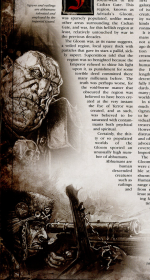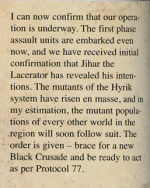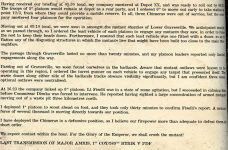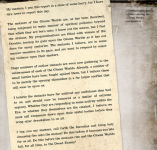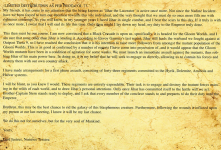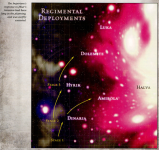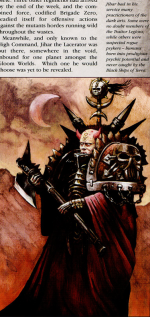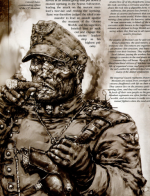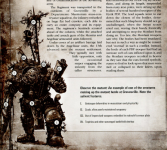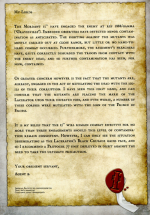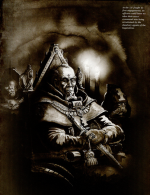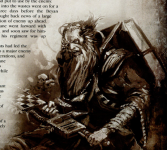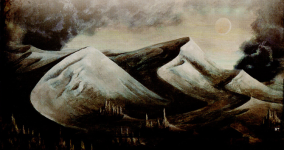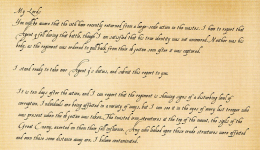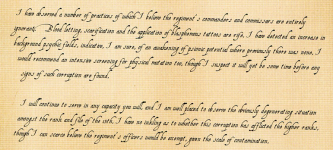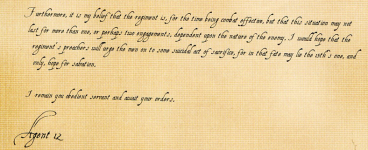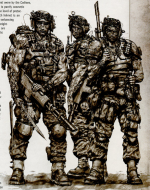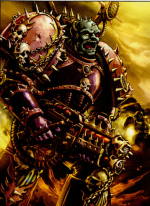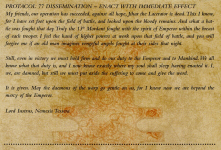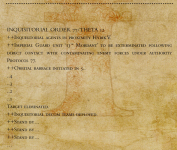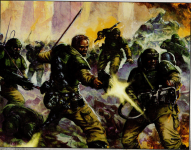SOME OF YOU WHO ARE ENTRUSTED WITH THE LIVES OF MEN MAY ONE DAY FIND THEIR VERY SOULS ENTRUSTED TO YOUR CARE TOO. THOUGH NONE MAY SPEAK OF SUCH THINGS OPENLY, YOU WILL BE NOW BE AWARE THAT THERE ARE FORCES AT LARGE IN THE UNIVERSE FAR MORE TERRIFYING THAN ANY XENOS, FAR MORE PERNICIOUS THAN ANY TRAITOR.
BUT, BEFORE YOU READ OF SUCH THINGS, YOU MUST TURN TO YOUR CONFESSOR FOR COUNSEL, AND CLEANSE YOUR HEART OF EVERY STAIN. FOR YOU MAY BE CALLED TO SERVE AGAINST THE MOST TERRIBLE FOE FACING MANKIND. YOU MAY BE REQUIRED TO FIGHT AN ENEMY AGAINST WHICH YOU WILL, WITH ALL CERTAINLY, FALL, EVEN SHOULD YOU BEAT HIM UPON THE FIELD OF BATTLE.
PROCEED THEN, WITH YOUR CONFESSOR’S BLESSING, AND READ OF BUT A SMALL PART OF THE THREAT PRESENTED BY MANKIND’S NEMESIS. LEARN FROM THE DEATHS OF THOSE WHO HAVE GONE BEFORE YOU, AND PRAY THAT YOU MAY SERVE THE EMPEROR AS WELL AS THEY. HEED UNTO THE LESSON OF THE 13™ MORDANT.
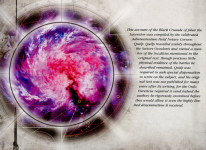
This account of the Black Crusade of Jihar the Lacerator was compiled by the celebrated Administratum Field Notary Corwen Quilp. Quilp travelled widely throughout the Sectors Occularis and visited a number of the localities mentioned in the original text, though precious little Physical evidence of the battles be described remained. Quilp was required 1o seek special dispensation to write on the subject, and bis original text was not published for many years after its writing, for the Ordo Hereticus required it (and indeed the author) be rigorously examined before they would allow it even the highly limited dissemination it received.
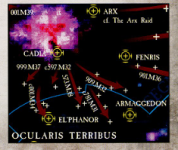
(Below, right.) Segmentum view of the Eye of Terror.

An unnamed lieutenant of the Lacerator, this individual haunted the nightmares of many of the 13th’s troopers. A number of battlefield myths surrounding her were born during the campaign, ranging from her prodigious ability with the blade to the tortures she might visit upon those her forces captured in battle. The 13th’s NCOs were hard-pressed to contain these tales, lest discipline break down entirely when fighting her warband.
Perhaps once or twice in a millennia, a truly great champion of the unnameable gods will arise in the Eye of Terror. Through the power : : of his implacable will and the favour of dark powers this cham- pion can weld together an unsteady alliance between the infernal regions of the Eye. How the champion brings the crusade together depends on his nature and his patron god. Some use manipulation, others extortion, others domination, others intimidation. Most simply use all of the considerable powers at their disposal.
Preparations for a Black Crusade can take years, or weeks depending on the whims of the gods. The forges of the hell worlds belch out armour and weapons for the chosen one’s followers, dark engines are aroused from their slumber with blood sacrifices, factions vie for com- mand of the massed ranks of crusaders or are crushed into obedience. When the Black Crusade is launched, the Eye of Terror vomits forth the diabol- ic hordes: armies of abominations, rank upon rank of huge, twisted monsters; numberless masses of cultists; wild tribes of mutants; ancient and terrifying traitor titans. Spearheading it all are the Traitor Legions, united in their lust for booty and their desire to bring destruction upon the hated Imperium.
The Imperium keeps strong forces sta- tioned around the Eye to fend off these invasions. Entire Titan Legions, Space Marine Chapters and massed regiments of Imperial Guard defend the most vital systems in close proximity to the Eye. But even powerful fighting formations like these cannot guarantee victory over the infernal throng. All too often, the black tide expands and recedes leaving entire systems ravaged and burned. Whole planetary populations are irrecoverably tainted, cities and industries are crushed by the thunderous pounding of diabolic engines of destruction, uncounted citizens are dragged away to serve as slaves and playthings to the damned souls and their daemonic masters at the edge of reality.
Each city ruined, every planet burned brings the Imperium a little closer to dissolution. In an Imperium of a million worlds how much can a single world matter? Enough to have to defend each one “against the infernal host, enough to bring ‘the curse of Exterminatus upon those that bend the knee and bow down to the dark ones. A Black Crusade may come crashing forth from the Eye only once in a thousand years but the damage it inflicts can never be undone.
Jihar the Lacerator
Few beings brought such grief upon the Domains of Man in the mid centuries of the thirty-eighth millennium as did the abomination known as Jihar the Lacerator. It is believed that Jihar served as an officer in the ranks of the traitorous Emperor’s Children, a former Astartes Legion that fell from the Emperor’s Grace at the very dawn of the Age of the Imperium. Jihar the Lacerator is known to follow those powers that may not be named, and in particular, that power known to revel in excess in all things. His service of these powers bas seen him slaughter countless millions of the Emperor’s servants, and raze entire worlds to ashes.
By the end of the sixth century of the thirty- eighth millennium, Jihar’s power was approaching its zenith. Feted by powers beyond the ken of mortal man, be preached bis message far and wide, drawing ever more followers to him until bis armies numbered untold millions. Jihar the Lacerator led not only bis followers drawn from the so-called Emperor’s Children legion, but a vast multitude of the most base scum cast out by Humanity. Those reviled for bearing the mark of the mutant, those who would cavort with fell powers, and those who simply refused to call the Emperor master, flocked to bis banner, until the ether, it was said, wailed at the prospect of bis coming.
Jihar was reputed to be possessed of the most terrible of gifts, granted unto him by bis fell master. So dark was Jihar’s soul, so utterly twisted was be that the souls of the warp wail in anguish at bis passing. Wherever be treads, be is accompanied by a woeful cacophony. The dead, who should by rights fear naught, fear above all what evils be might visit upon them, and scream out for deliverance so keenly that their voices bleed into the world of men. So terrible is this sound that it is said that to bear it is to have one’s sanity shattered completely, and irrecoverably, and thereby to enter the service of Jihar and bis patron, for all time.
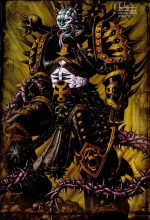
BUT, BEFORE YOU READ OF SUCH THINGS, YOU MUST TURN TO YOUR CONFESSOR FOR COUNSEL, AND CLEANSE YOUR HEART OF EVERY STAIN. FOR YOU MAY BE CALLED TO SERVE AGAINST THE MOST TERRIBLE FOE FACING MANKIND. YOU MAY BE REQUIRED TO FIGHT AN ENEMY AGAINST WHICH YOU WILL, WITH ALL CERTAINLY, FALL, EVEN SHOULD YOU BEAT HIM UPON THE FIELD OF BATTLE.
PROCEED THEN, WITH YOUR CONFESSOR’S BLESSING, AND READ OF BUT A SMALL PART OF THE THREAT PRESENTED BY MANKIND’S NEMESIS. LEARN FROM THE DEATHS OF THOSE WHO HAVE GONE BEFORE YOU, AND PRAY THAT YOU MAY SERVE THE EMPEROR AS WELL AS THEY. HEED UNTO THE LESSON OF THE 13™ MORDANT.

This account of the Black Crusade of Jihar the Lacerator was compiled by the celebrated Administratum Field Notary Corwen Quilp. Quilp travelled widely throughout the Sectors Occularis and visited a number of the localities mentioned in the original text, though precious little Physical evidence of the battles be described remained. Quilp was required 1o seek special dispensation to write on the subject, and bis original text was not published for many years after its writing, for the Ordo Hereticus required it (and indeed the author) be rigorously examined before they would allow it even the highly limited dissemination it received.

(Below, right.) Segmentum view of the Eye of Terror.

An unnamed lieutenant of the Lacerator, this individual haunted the nightmares of many of the 13th’s troopers. A number of battlefield myths surrounding her were born during the campaign, ranging from her prodigious ability with the blade to the tortures she might visit upon those her forces captured in battle. The 13th’s NCOs were hard-pressed to contain these tales, lest discipline break down entirely when fighting her warband.
Perhaps once or twice in a millennia, a truly great champion of the unnameable gods will arise in the Eye of Terror. Through the power : : of his implacable will and the favour of dark powers this cham- pion can weld together an unsteady alliance between the infernal regions of the Eye. How the champion brings the crusade together depends on his nature and his patron god. Some use manipulation, others extortion, others domination, others intimidation. Most simply use all of the considerable powers at their disposal.
Preparations for a Black Crusade can take years, or weeks depending on the whims of the gods. The forges of the hell worlds belch out armour and weapons for the chosen one’s followers, dark engines are aroused from their slumber with blood sacrifices, factions vie for com- mand of the massed ranks of crusaders or are crushed into obedience. When the Black Crusade is launched, the Eye of Terror vomits forth the diabol- ic hordes: armies of abominations, rank upon rank of huge, twisted monsters; numberless masses of cultists; wild tribes of mutants; ancient and terrifying traitor titans. Spearheading it all are the Traitor Legions, united in their lust for booty and their desire to bring destruction upon the hated Imperium.
The Imperium keeps strong forces sta- tioned around the Eye to fend off these invasions. Entire Titan Legions, Space Marine Chapters and massed regiments of Imperial Guard defend the most vital systems in close proximity to the Eye. But even powerful fighting formations like these cannot guarantee victory over the infernal throng. All too often, the black tide expands and recedes leaving entire systems ravaged and burned. Whole planetary populations are irrecoverably tainted, cities and industries are crushed by the thunderous pounding of diabolic engines of destruction, uncounted citizens are dragged away to serve as slaves and playthings to the damned souls and their daemonic masters at the edge of reality.
Each city ruined, every planet burned brings the Imperium a little closer to dissolution. In an Imperium of a million worlds how much can a single world matter? Enough to have to defend each one “against the infernal host, enough to bring ‘the curse of Exterminatus upon those that bend the knee and bow down to the dark ones. A Black Crusade may come crashing forth from the Eye only once in a thousand years but the damage it inflicts can never be undone.
Jihar the Lacerator
Few beings brought such grief upon the Domains of Man in the mid centuries of the thirty-eighth millennium as did the abomination known as Jihar the Lacerator. It is believed that Jihar served as an officer in the ranks of the traitorous Emperor’s Children, a former Astartes Legion that fell from the Emperor’s Grace at the very dawn of the Age of the Imperium. Jihar the Lacerator is known to follow those powers that may not be named, and in particular, that power known to revel in excess in all things. His service of these powers bas seen him slaughter countless millions of the Emperor’s servants, and raze entire worlds to ashes.
By the end of the sixth century of the thirty- eighth millennium, Jihar’s power was approaching its zenith. Feted by powers beyond the ken of mortal man, be preached bis message far and wide, drawing ever more followers to him until bis armies numbered untold millions. Jihar the Lacerator led not only bis followers drawn from the so-called Emperor’s Children legion, but a vast multitude of the most base scum cast out by Humanity. Those reviled for bearing the mark of the mutant, those who would cavort with fell powers, and those who simply refused to call the Emperor master, flocked to bis banner, until the ether, it was said, wailed at the prospect of bis coming.
Jihar was reputed to be possessed of the most terrible of gifts, granted unto him by bis fell master. So dark was Jihar’s soul, so utterly twisted was be that the souls of the warp wail in anguish at bis passing. Wherever be treads, be is accompanied by a woeful cacophony. The dead, who should by rights fear naught, fear above all what evils be might visit upon them, and scream out for deliverance so keenly that their voices bleed into the world of men. So terrible is this sound that it is said that to bear it is to have one’s sanity shattered completely, and irrecoverably, and thereby to enter the service of Jihar and bis patron, for all time.




